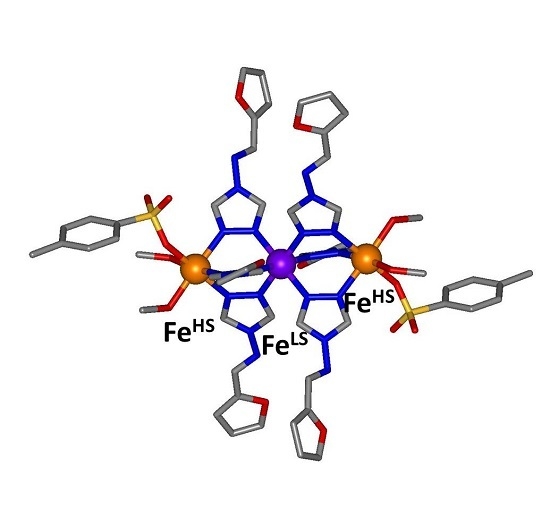Structure and Magnetic Properties of the Spin Crossover Linear Trinuclear Complex [Fe3(furtrz)6(ptol)2(MeOH)4]·4(ptol)·4(MeOH) (furtrz: furanylidene-4H-1,2,4-triazol-4-amine ptol: p-tolylsulfonate)
Abstract
:1. Introduction
2. Results and Discussion
2.1. Synthesis and Characterisation
2.2. Magnetic Susceptibility Measurements
2.3. Structural Characterisation
3. Experimental Section
3.1. Synthesis of furanylidene-4H-1,2,4-triazol-4-amine (furtrz)
3.2. Synthesis of [Fe3(furtrz)6(ptol)2(MeOH)4]·4(ptol)·4(MeOH)
3.3. Magnetic Measurements
3.4. Single Crystal Diffraction
4. Conclusions
Supplementary Files
Supplementary File 1Acknowledgments
Author Contributions
Conflicts of Interest
References
- Gütlich, P.; Goodwin, H.A. Spin crossover—An overall perspective. Top. Curr. Chem. 2004, 233–235, 1–47. [Google Scholar]
- Gütlich, P.; Gaspar, A.B.; Garcia, Y. Spin state switching in iron coordination compounds. Beilstein J. Org. Chem. 2013, 9, 342–391. [Google Scholar] [CrossRef] [PubMed]
- Halcrow, M.A. Spin-Crossover Materials: Properties and Applications; John Wiley & Sons, Ltd.: Oxford, UK, 2013. [Google Scholar]
- Bousseksou, A.; Molnár, G.; Real, J.A.; Tanaka, K. Spin crossover and photomagnetism in dinuclear iron(II) compounds. Coord. Chem. Rev. 2007, 251, 1822–1833. [Google Scholar] [CrossRef]
- Olguín, J.; Brooker, S. Spin-Crossover in Discrete Polynuclear Complexes, in Spin-Crossover Materials: Properties and Applications; John Wiley & Sons, Ltd.: Oxford, UK, 2013. [Google Scholar]
- Neville, S.M. Metallosupramolecular materials for magnetic applications: Spin-crossover. In Functional Metallosupramolecular Materials; Hardy, G.J., Schacher, F.H., Eds.; Royal Society of Chemistry: Cambridge, UK, 2015; pp. 290–317. [Google Scholar]
- Ren, D.-H.; Qiu, D.; Pang, C.Y.; Li, Z.; Gu, Z.-G. Chiral tetrahedral iron(II) cages: Diastereoselective subcomponent self-assembly, structure interconversion and spin-crossover properties. Chem. Commun. 2015, 51, 788–791. [Google Scholar] [CrossRef] [PubMed]
- Duriska, M.B.; Neville, S.M.; Moubaraki, B.; Cashion, J.D.; Halder, G.J.; Chapman, K.W.; Baldé, C.; Létard, J.-F.; Murray, K.S.; Kepert, C.J.; et al. A Nanoscale Molecular Switch Triggered by Thermal, Light, and Guest Perturbation. Angew. Chem. Int. Ed. 2009, 48, 2549–2552. [Google Scholar] [CrossRef] [PubMed]
- Steinert, M.; Schneider, B.; Dechert, S.; Demeshko, S.; Meyer, F. A trinuclear defect-grid iron(II) spin crossover complex with a large hysteresis loop that is readily silenced by solvent vapor. Angew. Chem. Int. Ed. 2014, 53, 6135–6139. [Google Scholar] [CrossRef] [PubMed]
- Bilbeisi, R.A.; Zarra, S.; Feltham, H.L.C.; Jameson, G.N.L.; Clegg, J.K.; Brooker, S.; Nitschke, J.R. Guest Binding Subtly Influences Spin Crossover in an FeII4L4 Capsule. Chem. Eur. J. 2013, 19, 8058–8062. [Google Scholar] [CrossRef] [PubMed]
- Ferguson, A.; Squire, M.A.; Siretanu, D.; Mitcov, D.; Mathonière, C.; Clérac, R.; Kruger, P.E. A face-capped [Fe4L4]8+ spin crossover tetrahedral cage. Chem. Commun. 2013, 49, 1597–1599. [Google Scholar] [CrossRef] [PubMed]
- Hietsoi, O.; Dunk, P.W.; Stout, H.D.; Arroyave, A.; Kovnir, K.; Irons, R.E.; Kassenova, N.; Erkasov, R.; Achim, C.; Shartruk, M. Spin crossover in tetranuclear Fe(II) complexes, {(tpma)Fe(m-CN)4}X4 (X = ClO4-, BF4-). Inorg. Chem. 2014, 53, 13070–13077. [Google Scholar] [CrossRef] [PubMed]
- Matsumoto, T.; Newton, G.N.; Shiga, T.; Hayami, S.; Matsui, Y.; Okamoto, H.; Kumai, R.; Murakami, Y.; Oshio, H. Programmable spin-state switching in a mixed-valence spin-crossover iron grid. Nat. Commun. 2014, 5, 3865–3873. [Google Scholar] [CrossRef] [PubMed]
- Halcrow, M.A. Structure:function relationships in molecular spin-crossover complexes. Chem. Soc. Rev. 2011, 40, 4119–4142. [Google Scholar] [CrossRef] [PubMed]
- Thomann, M.; Kahn, O.; Guilhem, J.; Varret, F. Spin Conversion versus Antiferromagnetic Interaction in Iron(II) Trinuclear Species. Crystal Structures and Magnetic Properties of [Fe3(p-MeOptrz)6(H2O)4](BF4)6 and [Fe3(p-MeOptrz)6(H2O)6](tos)6 [p-MeOptrz = 4-p-Methoxyphenyl)-1,2,4-triazole, tos =Tosylate]. Inorg. Chem. 1994, 33, 6029–6037. [Google Scholar]
- Savard, D.; Cook, C.; Enright, G.D.; Korobkov, I.; Burchell, T.J.; Murugesu, M. Gradual spin crossover behaviour in a linear trinuclear FeII complex. Cryst. Eng. Commun. 2011, 13, 5190–5197. [Google Scholar] [CrossRef]
- Garcia, Y.; Guionneau, P.; Bravic, G.; Chasseau, D.; Howard, J.A.K.; Kahn, O.; Ksenofontov, V.; Reiman, S.; Gütlich, P. Synthesis, Crystal Structure, Magnetic Properties and 57Fe Mössbauer Spectroscopy of the New Trinuclear [Fe3(4-(2′-hydroxyethyl)-1,2,4-triazole)6(H2O)6](CF3SO3)6 Spin Crossover Compound. Eur. J. Inorg. Chem. 2000, 2000, 1531–1538. [Google Scholar] [CrossRef]
- Gómez, V.; Benet-Buchholz, J.; Martin, E.; Galán-Mascarós, J.R. Hysteretic Spin Crossover above Room Temperature and Magnetic Coupling in Trinuclear Transition-Metal Complexes with Anionic 1,2,4-Triazole Ligands. Chem. Eur. J. 2014, 20, 5369–5379. [Google Scholar] [CrossRef] [PubMed]
- Grosjean, A.; Négrier, P.; Bordet, P.; Etrillard, C.; Mondieig, D.; Pechev, S.; Lebraud, E.; Létard, J.-F.; Guionneau, P. Crystal Structures and Spin Crossover in the Polymeric Material [Fe(Htrz)2(trz)](BF4) Including Coherent-Domain Size Reduction Effects. Eur. J. Inorg. Chem. 2013, 2013, 796–802. [Google Scholar] [CrossRef]
- Roubeau, O. Triazole-Based One-Dimensional Spin-Crossover Coordination Polymers. Chem. Eur. J. 2012, 18, 15230–15244. [Google Scholar] [CrossRef] [PubMed]
- Roubeau, O.; Gamez, P.; Teat, S.J. Dinuclear Complexes with a Triple N1,N2-Triazole Bridge that Exhibit Partial Spin Crossover and Weak Antiferromagnetic Interactions. Eur. J. Inorg. Chem. 2013, 2013, 934–942. [Google Scholar] [CrossRef]
- CrysAlisPro, V1.171.136.128; Agilent Technologies: Yarnton, Oxfordshire, England, 2013.
- Barbour, L.J. X-Seed—A software tool for supramolecular crystallography. J. Supramol. Chem. 2001, 1, 189–191. [Google Scholar] [CrossRef]
- Sheldrick, G.M. A short history of SHELX. Acta Crystallogr. Sec. A 2008, 64, 112–122. [Google Scholar] [CrossRef] [PubMed]

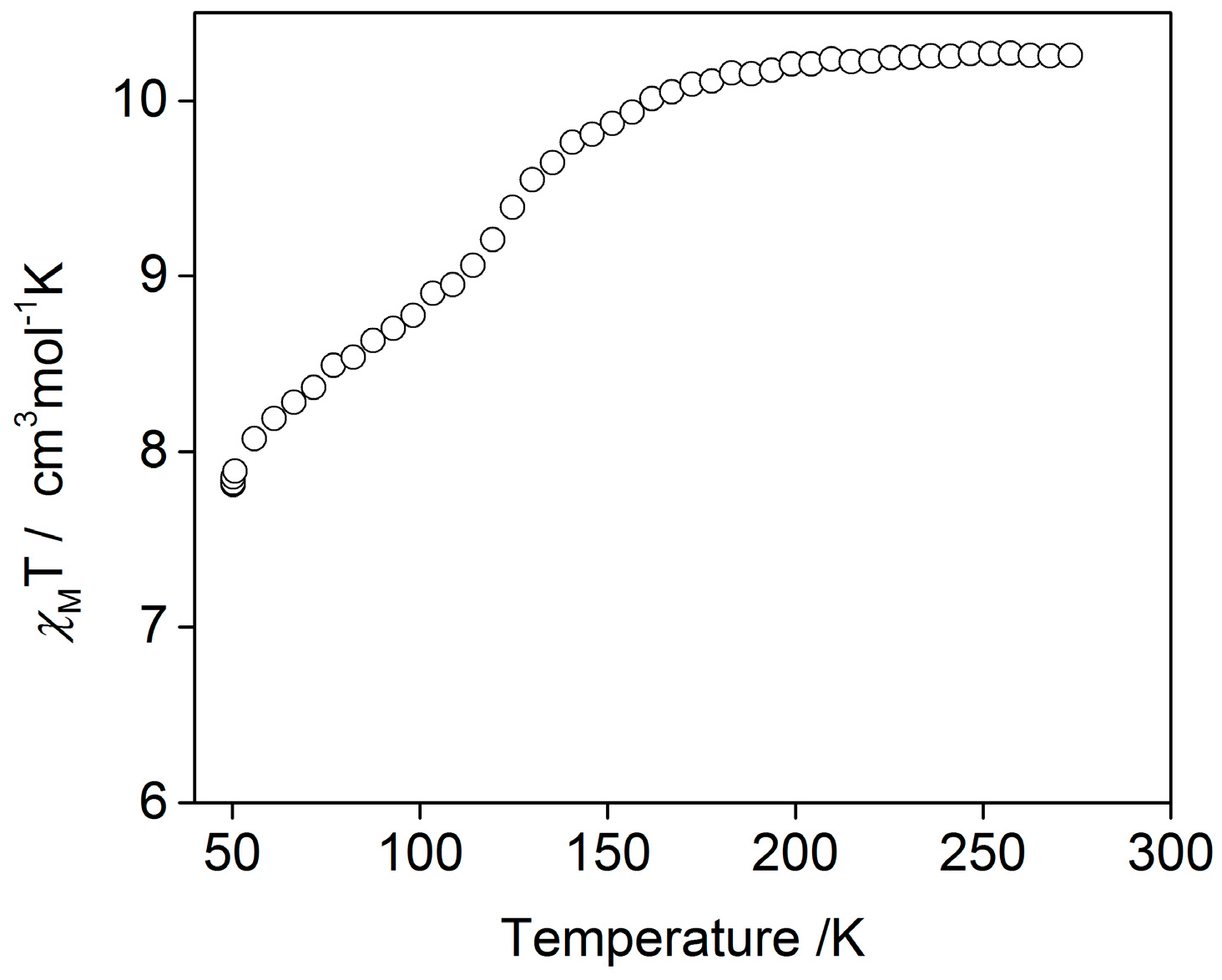
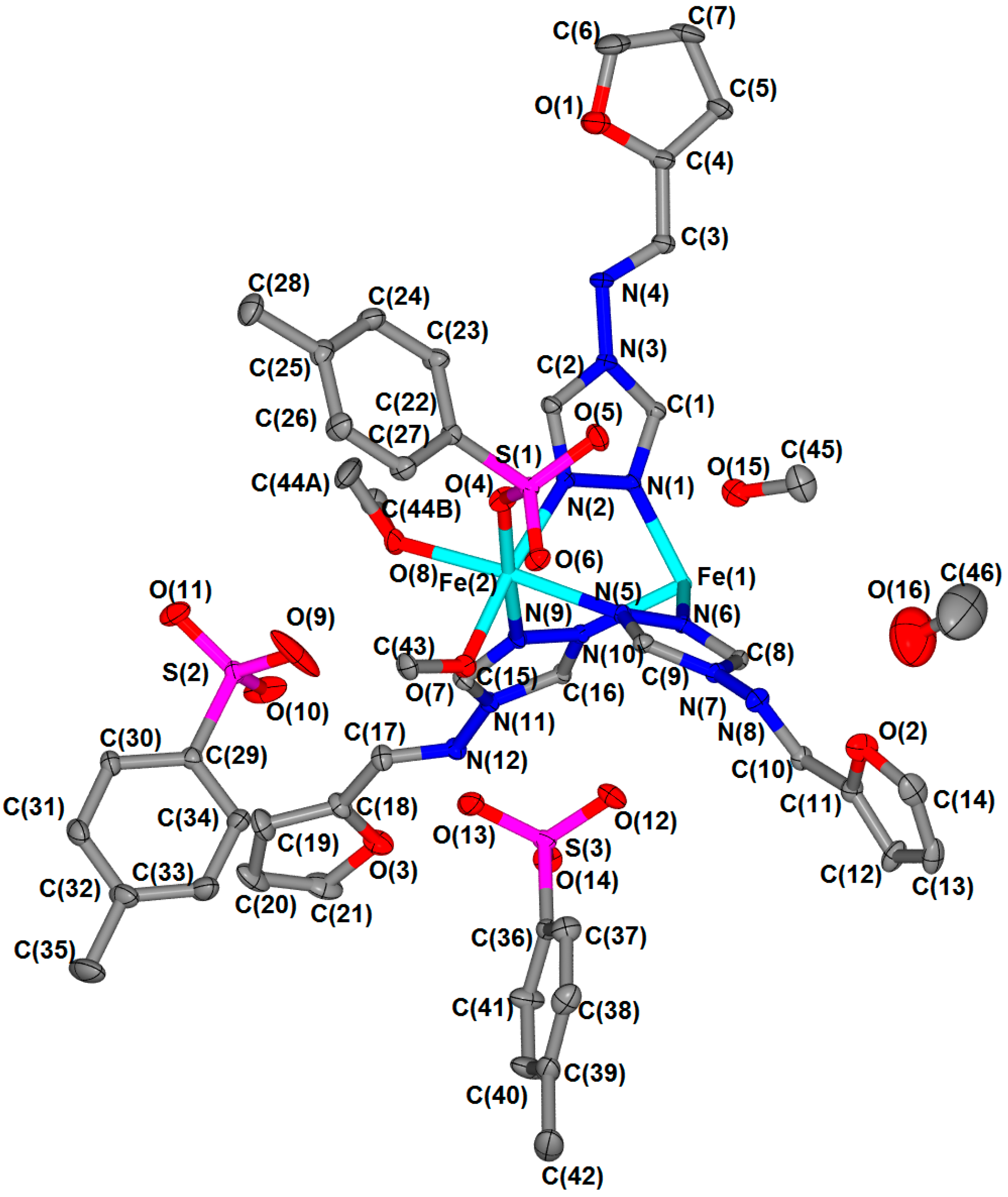
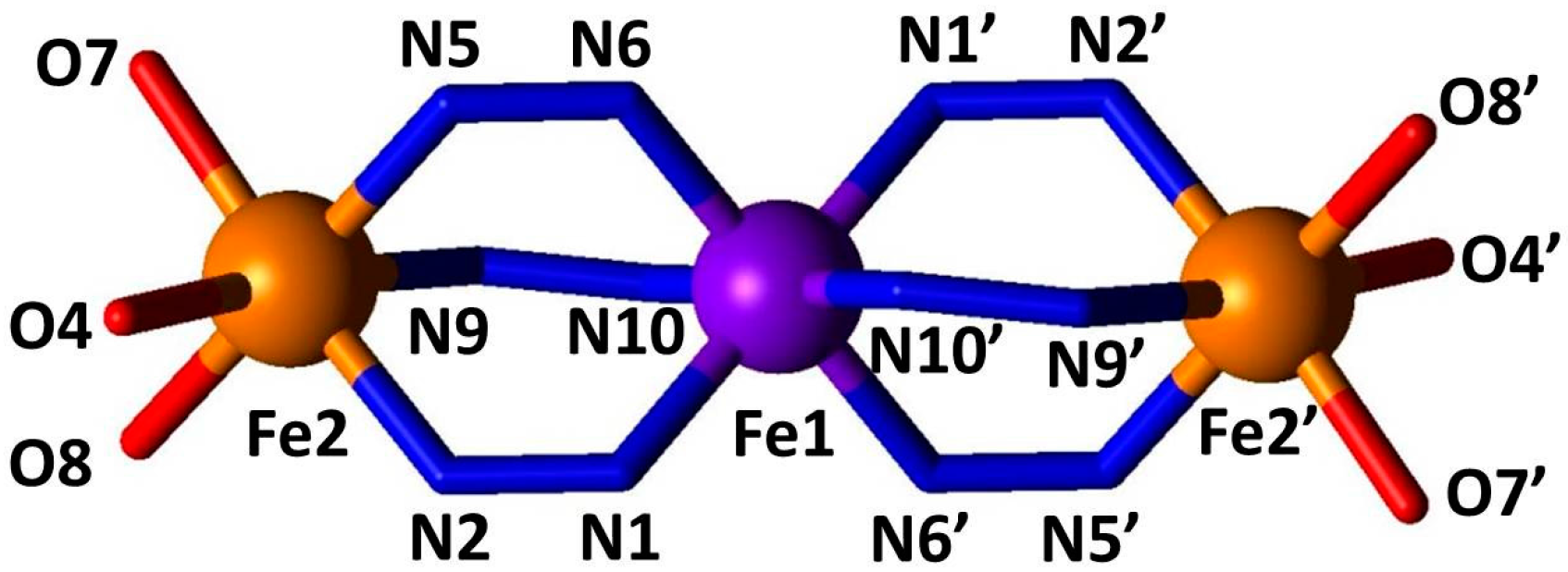
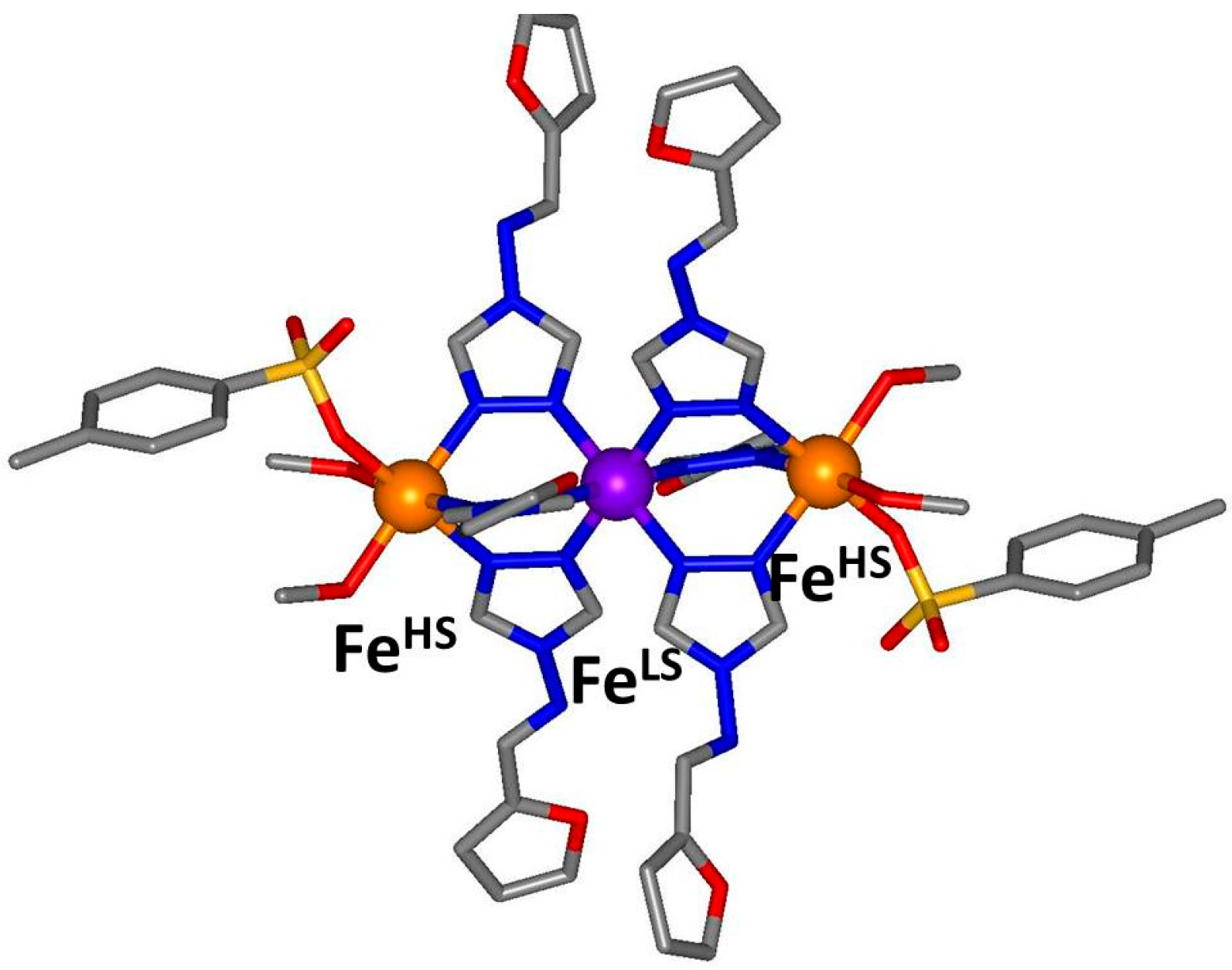

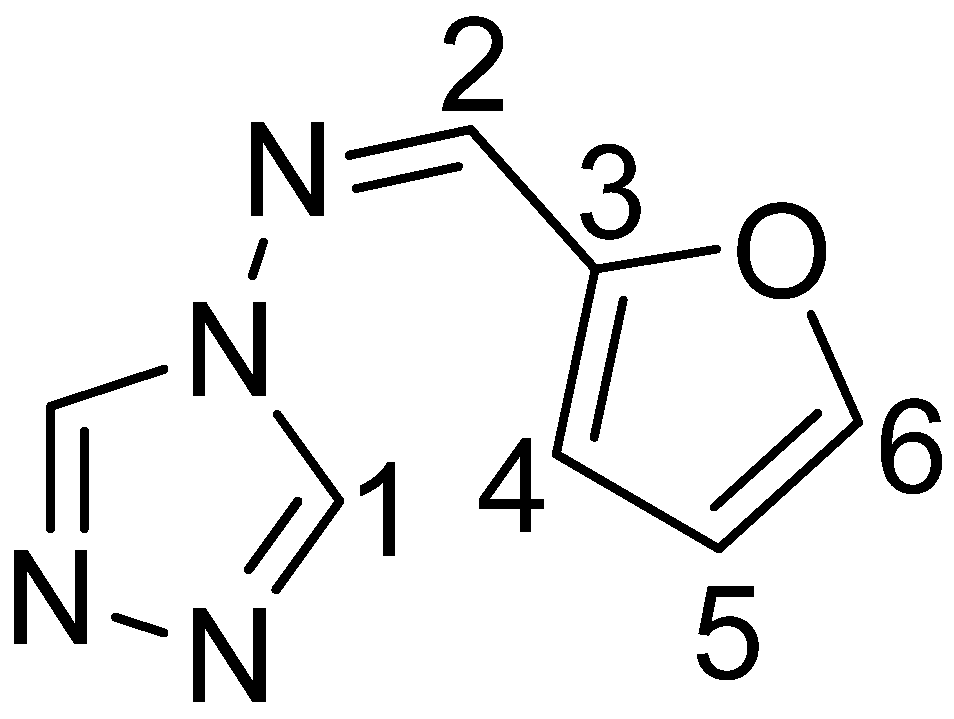
| Bond | /Å | Angle | /° |
|---|---|---|---|
| Fe1–N1 | 2.0274(18) | N1–Fe1–N6 | 91.65(7) |
| Fe1–N6 | 2.0131(17) | N1–Fe1–N10 | 91.91(7) |
| Fe1–N10 | 2.0169(18) | N6–Fe1–N10 | 91.46(7) |
| Fe2–N2 | 2.1366(18) | N2–Fe2–N5 | 85.85(7) |
| Fe2–N5 | 2.1260(18) | N2–Fe2–N9 | 87.48(7) |
| Fe2–N9 | 2.1789(18) | N5–Fe2–N9 | 86.78(7) |
| Fe2–O4 | 2.1066(17) | N2–Fe2–O4 | 86.53(7) |
| Fe2–O7 | 2.0872(16) | N2–Fe2–O8 | 96.82(7) |
| Fe2–O8 | 2.0995(17) | N5–Fe2–O4 | 94.13(7) |
| - | - | N5–Fe2–O7 | 87.96(7) |
| - | - | N9–Fe2–O7 | 94.67(7) |
| - | - | N9–Fe2–O8 | 88.97(8) |
| - | - | O4–Fe2–O7 | 91.42(7) |
| - | - | O4–Fe2–O8 | 90.41(8) |
| - | - | O7–Fe2–O8 | 89.54(7) |
| Interactions | /Å |
|---|---|
| Intramolecular | - |
| O6…C9 | 3.200(2) |
| Intermolecular interactions (trinuclear…trinuclear) | - |
| O1…C19_$1 | 3.444(2) |
| N12…C6_$2 | 3.488(3) |
| Intermolecular interactions (trinuclear…free anion) | - |
| C17…O10 | 3.074(2) |
| C3…O14 | 3.194(4) |
| C8…O11_$3 | 3.024(4) |
| C1…O12_$4 | 3.288(6) |
| Intermolecular interactions (bound anion…solvent) | - |
| O5…O15 | 2.817(2) |
| Intermolecular interactions (free anion…solvent) | - |
| O9…O7 | 3.247(4) |
| O13…O7 | 2.628(4) |
| π-stacking furan ring | - |
| O3 ring centroid…centroid | 3.553 |
| Ligand torsion angles | /° |
| Ligand O1 | 21.0 |
| Ligand O2 | 58.5 |
| Ligand O3 | 20.8 |
| Temperature [K] | 90 |
|---|---|
| Formula | C92H80Fe3N24O32S6 |
| Formula weight [g ·mol–1] | 2393.71 |
| Crystal system | Triclinic |
| Space group | P-1 |
| a [Å] | 12.0480(4) |
| b [Å] | 15.1401(5) |
| c [Å] | 16.3117(5) |
| α [°] | 96.793(3) |
| β [°] | 109.986(3) |
| γ [°] | 100.624(3) |
| V [Å3] | 2694.80(15) |
| Dc [Mg m–3] | 1.508 |
| Data/restraints/parameters | 18122/0/177 |
| R(F) (I > σ(I), all) | 0.0537, 0.0790 |
| Rw(F2) (I > 2σ(I), all) | 0.1364, 0.1568 |
| GoF | 0.946 |
© 2016 by the authors; licensee MDPI, Basel, Switzerland. This article is an open access article distributed under the terms and conditions of the Creative Commons by Attribution (CC-BY) license (http://creativecommons.org/licenses/by/4.0/).
Share and Cite
Klein, Y.M.; Sciortino, N.F.; Housecroft, C.E.; Kepert, C.J.; Neville, S.M. Structure and Magnetic Properties of the Spin Crossover Linear Trinuclear Complex [Fe3(furtrz)6(ptol)2(MeOH)4]·4(ptol)·4(MeOH) (furtrz: furanylidene-4H-1,2,4-triazol-4-amine ptol: p-tolylsulfonate). Magnetochemistry 2016, 2, 7. https://doi.org/10.3390/magnetochemistry2010007
Klein YM, Sciortino NF, Housecroft CE, Kepert CJ, Neville SM. Structure and Magnetic Properties of the Spin Crossover Linear Trinuclear Complex [Fe3(furtrz)6(ptol)2(MeOH)4]·4(ptol)·4(MeOH) (furtrz: furanylidene-4H-1,2,4-triazol-4-amine ptol: p-tolylsulfonate). Magnetochemistry. 2016; 2(1):7. https://doi.org/10.3390/magnetochemistry2010007
Chicago/Turabian StyleKlein, Y. Maximilian, Natasha F. Sciortino, Catherine E. Housecroft, Cameron J. Kepert, and Suzanne M. Neville. 2016. "Structure and Magnetic Properties of the Spin Crossover Linear Trinuclear Complex [Fe3(furtrz)6(ptol)2(MeOH)4]·4(ptol)·4(MeOH) (furtrz: furanylidene-4H-1,2,4-triazol-4-amine ptol: p-tolylsulfonate)" Magnetochemistry 2, no. 1: 7. https://doi.org/10.3390/magnetochemistry2010007
APA StyleKlein, Y. M., Sciortino, N. F., Housecroft, C. E., Kepert, C. J., & Neville, S. M. (2016). Structure and Magnetic Properties of the Spin Crossover Linear Trinuclear Complex [Fe3(furtrz)6(ptol)2(MeOH)4]·4(ptol)·4(MeOH) (furtrz: furanylidene-4H-1,2,4-triazol-4-amine ptol: p-tolylsulfonate). Magnetochemistry, 2(1), 7. https://doi.org/10.3390/magnetochemistry2010007






